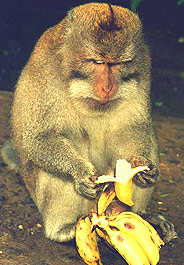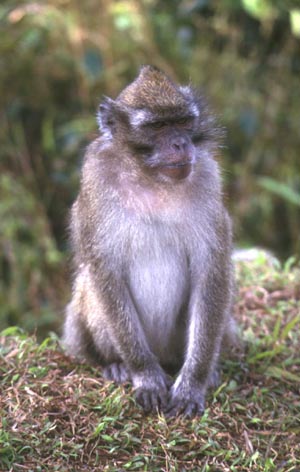


Common Name: Crab-eating Macaque, Long-tailed Macaque
Scientific Name: Macaca fascicularis
Classification: Macaca fascicularis is in the family Cercopithecidae and subfamily Cercopithecinae. There are 16 species of macaques. Based on mating style and reproductive systems, there are 4 subgroups. The crab-eating or long-tailed macaque group, also includes the rhesus macaque, the Japanese macaque (snow monkey), and the Formosan rock macaque. The other three groups are the silenus-sylavanus, sinica, and artoides.
Phylum or Division: Chordata
Class: Mammalia
Order: Primates
Family: Cercopithecidae
Subfamily: Cercopithecinae
Identification:
Macaca fascicularis is a
crab-eating macaque or long-tailed macaque (38-55 centimeters long with
a tail, 40-65 centimeters in length, weighing 4-8 kilograms). The males
and females are both born with black fur, which turns a grey to dark
brown or yellowish-brown with lighter underparts and crown hairs which
form a small crest. Crab-eating macaques are a quadrapedal and diurnal
(active during the day) species, highly adapted for swimming and
climbing trees with tails used for balance when leaping between trees.
Crab-eating macaques have an average group size of 30 individuals.
Original Distribution: South East Asia (Indonesia and Philippines to South Burma)
Current Distribution: Mauritius and Tinjil (Islands in the Indian Ocean), Indochina, Myanmar (Burma), Malaysia, Sumatra, Borneo, Java, Vietnam, Laos, Cambodia, Borneo, Thailand, Philippines, and other small islands. Their classic habitats are mangrove forests as high as 2000 meters as well as, riverine, coniferous, deciduous, and swamp forests, preferring edge habitats.
Site and Date of Introduction: Macaca fascicularis is native to south east Asia. They were introduced to the island of Mauritius in the early 1600, where they have proliferated.
Mode(s) of Introduction: Macaca fascicularis has been introduced to the above regions mentioned by means of live-trapping for export and medical research. The local dispersal methods are characterized as self-propelled and naturally spreading.
Reason(s) Why it has Become Established: In the early 1600, Macaca fascicularis was introduced to Mauritius when there were not predators or mammal competitors. As a result, these species populated this region at a rapid rate. They were in part introduced to Mauritius, because of the Japanese red cedar plantations found there, alleviating the macaque threat of predation on the eggs and chicks of endangered forest birds. Crab-eating macaques are highly adaptable because they are generalist feeders with a diet consisting primarily of fruit and seeds, as well as birds, insects, stems, crustaceans, spiders, leaves, invertebrates, and bird eggs. Their cheek pouches carry food while they forage and they place their hands inside burrows in search of crabs and shellfish.
Ecological Role: Crab-eating macaques are the most extensively used laboratory animal next to the rhesus monkey. They are able to easily adapt to mangrove forests, distributed throughout a variety of island habitats, feeding on native fruits and subsequently competing with native birds.
Benefit(s): The crab-eating macaques were extensively used as the laboratory animal for the research and development of the polio vaccine. In addition, they help in the distribution of introduced plant species.
Threat(s): Some believe that the Crab-eating macaque is responsible for the extinction of forest birds in and the destruction of agriculture, raiding crops (sugar cane) and eating food such as rice and taro plants. Crab-eating macaques threaten critical bird breeding areas. The crab-eating macaque has made it to the Invasive Species Specialist group of the World Conservation Union's list of "100 of the World's Worst Invasive Alien Species."
Control Level Diagnosis: The control level does not seem to be a high priority in all the areas it inhabits. The level of control varies from virtually no protection to being well-protected depending on the region. There seems to be some regulation through export regulations but none that are extensive. The crab-eating macaque inhabits two sanctuaries, nine national parks, and nine reserves. They receive some protection in temple ruins where they are hand fed on a regular basis. The crab-eating macaque is legally protected in the parks and urban forests of Malaysia. They are threatened in some of the reserves due to oil drilling and harvesting plans. They are considered sacred by some in Bali. This may increase the chances of their survival in these reserves. Crab-eating macaques are hunted for food in Thailand and Borneo and because they are agricultural pests, which remains a growing problem. As a result, this has impeded the government from following through with conservation efforts. Crab-eating macaques were exported to the United States and Great Britain for biomedical research. In the wild, there are currently approximately 2.5 million crab-eating macaques, but they are threatened by extensive logging causing habitat loss.
Control Method: The Mauritian government has not practiced lethal control as a management option due to socio-religious reasons. As an alternative, the government has used live-trapping for export and research. Officials have not been successful in using scare tactics on the macaques to prevent them from destroying bird nests. There is a quota system in place, which regulates the export of this species. In Thailand, a license is necessary in order to capture, hunt, or keep a crab-eating macaques in captivity.